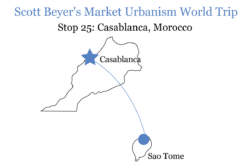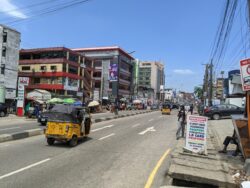The Ingenuity of Third World Ridesharing
While commercial carpooling drags along in the U.S., there's much competition and innovation in the developing world.
Morocco, like much of the 3rd world, grasps a transport concept that hasn’t taken hold in today’s urban America. Stand on a corner in Casablanca, raise your arm, and one of the city’s red cabs will stop. Hop in and soon enough you’ll have company. The driver will stop for other people waving their arms, ask their destinations, and either accept them or move on. If he accepts, that means the metered price now is split between 2, 3, even 4 riders.
Such informal carpooling, done through quick street negotiation, is part of the fabric of Third World societies. It helps explain how they’ve built such ingenious ridesharing systems.
For contrast, look at how UberPool went in the U.S. It was often ineffective at grouping passengers, and even when doing so, involved unwanted detours. Uber shuttered the service during Covid, and is now rolling out a similar UberX Share in select cities. That’s right: a well-capitalized company with the benefit of e-hailing tech and smart routing couldn’t master what Moroccans do intuitively without smartphones.

This example speaks to a trend I’ve witnessed during my 1.5-year journey through the Global South. Ridesharing in these regions is faster, cheaper and more efficient than the U.S. There are several reasons.
First, as I’ve alluded to, is this sharing culture – which extends beyond taxis. Jitney buses are also common in such countries, and people cram together inside them. Even little 3-wheel rickshaws, common in Tanzania, Nigeria and elsewhere, often carry 4 passengers.

Second is labor economics. Rideshare driving is actually a prestigious job in the Third World. As one Uber driver in Johannesburg explained, South Africa’s rural villages have little opportunity and zero clientele to support rideshare apps. So men move to big cities like Joburg and Cape Town. Their first participation in the market is usually being hired to drive someone else’s car. With time they save up and buy their own. To many South Africans this is a dream career. It also means there are lots of market entrants and downward price pressure.
Third is that there’s more corporate competition in the 3rd World. In the U.S., Uber and Lyft are a duopoly. In the developing world one will, depending on the region, find Didi, Bolt, Gett, Yango, Grab, and many lesser-known startups that serve certain niches. Licensed cabs are still prolific, but because of competition are forced to lower prices. Finally, there are many car-owning individuals who build client bases through word-of-mouth, outside of a brokerage app.
The net result benefits consumers. Drivers of cars, jitneys, rickshaws, motorbikes and more swarm through Global South cities looking to give rides. Wait times are typically under 2 minutes and most rides under $5. I’ve found (to my amazement) that after a little haggling, most drivers will give personalized city tours for between $5-10 per hour. In the U.S., the average Uber ride costs over $25 and wait times are often between 10 and 20 minutes.
Obviously, there are other factors for why ridesharing thrives in the Third World. It has lower incomes, driving labor costs, purchasing power, and thus trip prices down. The reason ridesharing culture is strong is that people don’t own cars and must by economic necessity commute together.
But this cultural acceptance bleeds over into the countries’ regulatory mindset (or lack thereof). While there is still protectionism – often enforced by private mafias – there’s far fewer formal government protocols.
U.S. cities, by contrast, have proven more intent on micro-managing how and where companies must operate, what they pay, what they can charge, etc. This helps explain why only two companies compete throughout our massive country. The result is driver scarcity, long wait times, high prices, and general lack of innovation compared to many poorer Third World countries.
Except where otherwise noted, images credited to Scott Beyer and The Market Urbanist.
Catalyst articles by Scott Beyer | Full Biography and Publications
